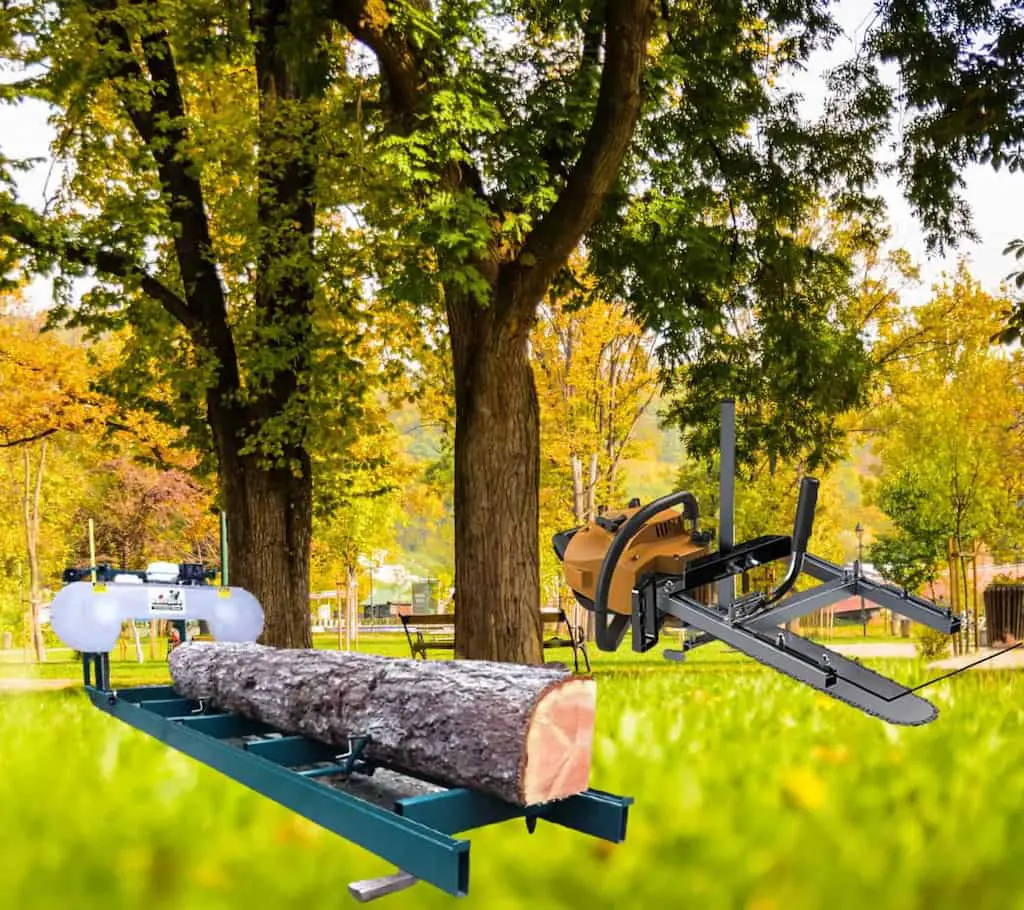What Is the Difference Between a Chainsaw and a Bandsaw Mill?

If you’re new to milling timber, you’re probably a little confused about some things – namely, the difference between chainsaw and bandsaw mills. Mills are a hefty investment, and it’s only natural you want to get your money’s worth from any product you decide on. What’s the difference between a chainsaw and a bandsaw mill?
Chainsaw mills cut vertically and are more portable than bandsaw mills, which cut horizontally and are typically more stationary. The former is better at cutting large, uniform chunks of wood, whereas bandsaw mills are better at mass-producing smaller boards of wood.
In this article, I’ll be covering the difference between chainsaw and bandsaw mills. This includes their capacities, abilities, and blades.
Chainsaw and Bandsaw Mills Explained
When looking at mills, you may notice that there are multiple types. Bandsaw mills are very popular these days, and chainsaw mills have maintained a niche in the mill world for their own unique advantages. Let’s look at how each of these mills works before we make a direct comparison later.
Chainsaw Mill
Chainsaw mills are sometimes called Alaskan Chainsaw Mills because they’re often used in remote areas such as the Alaskan wilderness.
These mills are designed to be smaller and more portable than bandsaw mills, making them suitable for transport by truck, ATV, or boat. The portability of a chainsaw mill comes at a price, though – they lack the versatility of a bigger, less portable mill.
These mills vary in design, but they mostly consist of a simple bracket to hold the chainsaw and a guide board into which you’ll feed your logs. Nicer models have true tracks like bandsaw mills, even if they’re more akin to ladders.
Chainsaw mills are ideal for cutting logs into smaller chunks, and are great at getting uniformly cut lumber you don’t have to go back and plane into straight shapes.
Bandsaw Mill
Bandsaw mills are becoming very popular for their versatility – cheaper models are nearly as portable as chainsaw mills. In contrast, bigger, more stationary bandsaw mills are more suitable for cutting large boards.
Bandsaw mills have narrow blades and are better at cutting hard, dense woods that would make chainsaw mills struggle, like oak, cherry, and ash. Dense woods would strain the motor of cheap mills, but bandsaw mills can handle just about anything.
Bandsaw mills usually have a carriage system to support the saw, and a rail system to load logs, and possibly even level. The blades on bandsaw mills cut the log horizontally, as opposed to most chainsaw mills, which cut vertically.
Something to look out for on bandsaw mills: They’re more likely than chainsaw mills to waver on cuts and produce ‘waves.’ If this happens, you’ll have to run the wood through a planer, and that’s extra work that didn’t have to happen.
While blade replacements are essential for any saw, bandsaw mills especially need regular blade changes so they don’t create wavy, curvy cuts – wavy boards would have to be fixed, meaning hours of extra work.
Chainsaw vs. Bandsaw: Which Is Better for Your Needs?
You may decide between a chainsaw and bandsaw mill solely based on the portability factor, but there are several other factors to consider as well. Below we’ll compare portability along with these other variables.
Production Capacity
This refers to how much wood you can cut in a day.
Chainsaw mills are very inefficient for this as compared to bandsaw mills – the latter has a narrower blade that maximizes efficiency and makes faster cutting possible.
If your goal is to cut as many logs as possible in the shortest period of time, then bandsaw mills are the best pick for you. Their narrow kerf is more economical, wasting less wood and producing less sawdust.
Portability
While some cheaper bandsaw mills are quite portable these days, chainsaw mills remain popular because they are the ultimate portable lumber mills. Even the bulkiest and most expensive chainsaw mills are perfect to take deep into the woods or way out in the wilderness anywhere.
For example, if you need to mill logs and build a log cabin on-site, a chainsaw mill would be perfect for that.
Bandsaw mills are better home or shop mills because they’re harder to set up and transport on a whim. If your intention is to bring logs to the mill and, for example, sell them to homeowners and furniture crafters, a bandsaw mill is a great choice.
Cutting Capacity
As far as cutting large slabs of wood, chainsaw mills have bandsaw mills beat. If you want to build large, flat tables, a chainsaw mill would be great for cutting those great slabs of lumber.
If you’re cutting lots of 1-inch (25.4-mm) boards, though, a bandsaw would be better; its narrower blade means you’ll wait less wood and produce more boards.
Then there’s the fact that bandsaw mills are just faster, so you’ll end up out-producing a chainsaw mill trying to do the same thing, not to mention they’ll be drowning in sawdust.
Blades
Chainsaws use totally different blades than bandsaw mills, and are virtually always thicker. This gives them a lower ‘kerf rating,’ which means how much wood is lost as sawdust waste on either side of a cut.
Bandsaw blades have a much lower kerf rating, making them more efficient when mass-producing lumber. Chainsaw mills produce a more uniform cut, though, whereas bandsaw mills can get a wavy cut when the blades get a little dull.
No matter which you end up getting, all blades get dull. Chainsaw mill blades can be sharpened with special metal files, though you may opt to simply replace the blade and chain when they get dull – this depends on your budget and whether you’re milling lumber professionally or not.
Is It Worth It To Get Your Own Mill?
A sawmill can be an excellent tool for anyone whose property features large numbers of trees. Over time, trees will die and fall, so why not make use of their timber? Whether you want to sell lumber or use it yourself for various projects, being able to cut it yourself helps a great deal.
Uses for lumber include:
- Woodworking
- Sheds and small buildings
- Fences and decks
- Construction
As you can see, there are tons of ways to use milled lumber, but many people also opt to get into milling for the money – trees such as cherry and walnut are precious to furniture makers. Even regular trees like maple and oak can be worth milling if you have a lot of them and know someone who wants to buy them.
Paying a sawyer to come to mill your logs for you can run as much as $50-80 an hour, according to Woodshop News. If you have a one-time need to mill lumber, this may be worth it, but if you have lots of wood, well, that price adds up. It’s certainly not feasible to call a sawyer if you have lots of logs lying around, so it only makes sense to look into getting your own mill.
Having a portable mill can make trees falling on your property less of a hassle and more of an opportunity, as long as you get to them before they rot! While wood prices vary greatly based on the type, age, and other variables, milling your own lumber can be a great side hustle – it may even grow into something bigger down the road!
Wrapping Up
Lumber mills can be confusing if you don’t know what you’re getting into, but chainsaw mills are more portable for cutting large chunks, whereas bandsaw mills are better for mass-producing smaller boards of wood.





